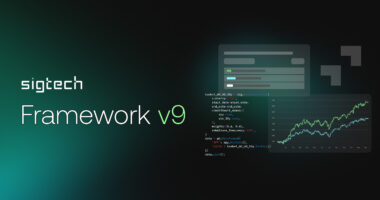by Sam Forster, Senior Product Manager & Peter Huber, Investment Writer
Detailed transaction cost modeling is an essential component in the research and development phase for systematic investment strategies. Unrealistic assumptions made during backtesting can significantly distort the perceived performance of a strategy, resulting in disappointing live trading results. SigTech’s quant technologies platform allows users to minimize these distortions and avoid this disappointment by providing a wide range of customizable transaction cost models, accounting for both direct and indirect costs.
This blog post demonstrates how to integrate realistic transaction cost modelling and its impact on research results.
Transaction cost models
Investors use a variety of models to simulate transaction costs. In this blog we focus on two commonly used models:
-
The constant spread model applies a fixed spread for each transaction.
-
The square root model follows the same form as our model above, with the exception that the spread is a function of both the asset’s volatility and the proportion of the average daily volume we trade (1).
Where σ denotes the asset’s volatility, ptc the proportion of the asset’s average daily volume (ADV) being traded and 𝛼, the exponent of participation, is implied from real transaction data (see fn. 1).
To visually showcase how this works, the chart below describes how market impact varies with participation as expressed by the value of ptc (i.e. proportion of ADV traded). The chart’s legend indicates the annual volatility and the value of the alpha exponent (⍺) introduced in the square root model above. As is observable in the graph, as the value of ⍺ increases, market impact falls. For instance, at the 0.8% participation rate, when annual volatility is 10% and alpha is 0.5, market impact is ~0.85%. When the value of alpha is increased to 1, market impact falls to ~0.07%.

Modeling transaction costs in practice
In practice, transaction costs can be reduced by imposing penalties that discourage excessive trading during the portfolio construction process. This blog draws on the work of Almgren & Chriss, utilizing two simple forms of penalty (2).
-
Linear trading costs are proportional to the absolute difference between new and old weights. These include bid-mid/ask-mid spreads, broker commissions and exchange fees and the strength of the effect is controlled by λ1 in our optimization function below.
-
Quadratic trading costs are proportional to the squared difference between new and old weights, corresponding to a market impact model that is linear in its rate of trading and represented by λ2 in our optimization function.
To demonstrate the impact from incorporating linear and quadratic costs into transaction modeling, we focus on a simple cross asset allocation strategy. (3) The portfolio weights are determined through a mean-variance optimization applying long-only and maximum weight constraints. The penalty terms can be incorporated into the optimization problem to deter portfolio turnover, as follows:

The strategy is denominated in USD and rebalances every week on a Friday. In order to determine the covariance matrix used for each optimization a lookback window of 60 days is used.
As part of the analysis, several versions of the strategy are run with varying assumptions about the parameters in the transaction cost models and the strategy’s underlying AUM.
To demonstrate the importance of applying realistic transaction costs during backtesting, we begin by testing the effects of not including any penalization for trading. As shown in the graph below, this results in excessive turnover, where the weight to each portfolio component shifts regularly.

However, as we introduce trading costs by increasing the coefficients of the penalty terms, trading becomes relatively more expensive resulting in a drastically reduced reallocation frequency. Such an increase (of the penalty term) may be the consequence of rising broker commissions and exchange fees, or increases in the spread between new and old portfolio weights.

In the extreme case, where transaction costs are excessively high, reallocation is minimal. The portfolio gradually converges towards a static allocation, as demonstrated in the graph below.

Finding the optimal transaction cost model
The following graph provides an overview of turnover as a function of the coefficients of the penalty terms, as expressed by λ1 and λ2 in our optimization equation. The values on the x-axis are expressed in terms of multiples of linear and quadratic costs. Unsurprisingly, as the penalties applied increase, the strategy’s turnover declines.

In order to assess the relative profitability of the strategies in the absence or presence of transaction costs, we calculate their Sharpe ratios (SRs). The table below compares the SRs for the square root model including transaction costs (TC) and excluding transaction costs (NO TC). The ratios of their respective SRs (i.e. Sharpe ratios excluding transaction costs relative to the ones applying transaction costs) are also included. Each column represents the coefficient of the penalty applied, expressed in terms of the fixed units.

As expected, when the penalty is high, the frequency of trading is reduced and we incur fewer trading costs. Hence, as penalties rise, the respective performances of the strategies (with and without transaction costs) converge. In our example, the strategies applying the highest penalties exhibit the highest Sharpe ratios. However, this ‘buy and hold’ strategy is of course not an universal optimum for all strategies, but rather highlights the need for implementing customized transaction cost modeling.
Transaction cost analysis with SigTech
Understanding transaction costs and effectively safeguarding against their potential eroding of a strategy’s profitability is an essential step in the investment process. Modeling these costs is therefore an indispensable part of backtesting.
The SigTech platform supports extensive transaction cost and market impact modeling within its event-driven backtesting engine. (4) Our comprehensive library of transaction cost functions range from the simple constant spread to sophisticated models accounting for market participation, instrument volatility and more. A range of default transaction models are also available for more complex asset classes (e.g. options, swaptions). Different transaction costs can be applied to asset class (e.g. equities, futures, bonds), instrument group (e.g. GC futures, NYSE equities, German government bonds), single instruments (e.g. AAPL, TSLA), or across a collection of these categories. Alternatively, users can integrate their own trading cost functions and upload their own proprietary trading data, thus facilitating the construction of highly detailed bespoke models.
Contact us to learn more about how to optimize your transaction cost modeling.
References
(1) N.B. It isn’t necessary to take the square root (i.e. 𝛼 = 0.5); an alternative exponent can be substituted.
(2) Almgren, R. and Chriss, N. (2000) Optimal Execution of Portfolio Transactions
(3) Our universe comprises 29 individual ETFs; 19 global equity market ETFs, 5 bond ETFs, 4 commodity ETFs, and 1 real estate ETF.
(4) To discover how to analyze transaction costs on the SigTech platform, visit our user guide page.
Disclaimer
This content is not, and should not be construed as financial advice or an invitation to purchase financial products. It is provided for information purposes only and is subject to the terms and conditions of our disclaimer which can be accessed here.




